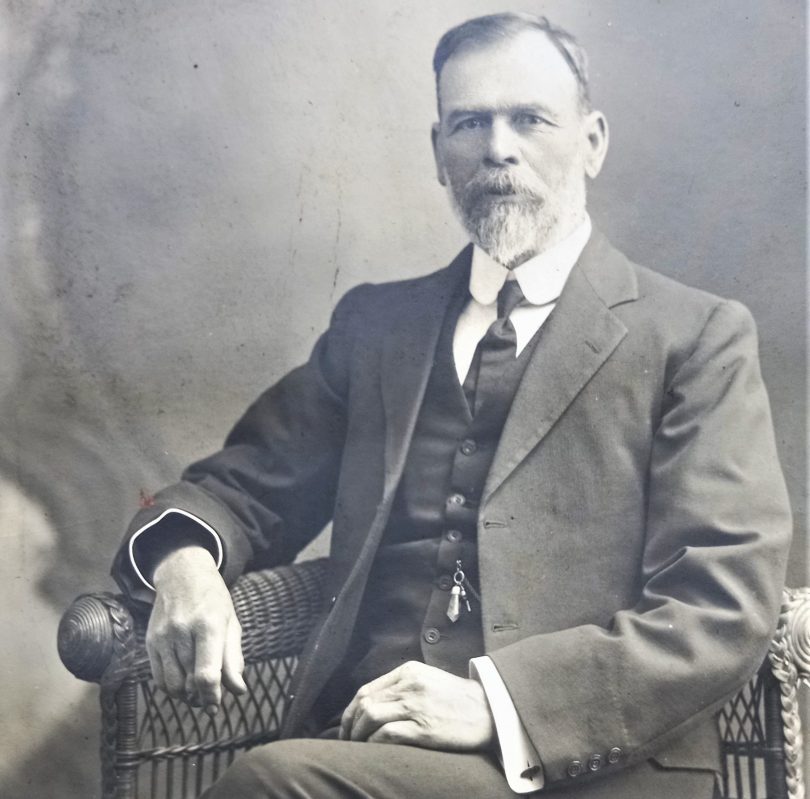
Builder Frederick Young was a quiet man who had a significant impact on Canberra in the early 20th century. Photo: Supplied.
A lot of blood, sweat and tears went into building our national capital. Architect Walter Burley Griffin is well known, as is King O’Malley, the Home Affairs Minister who laid the Foundation Stone for Canberra in 1913. But who remembers Frederick Young?
People living in Young Street, Queanbeyan, may wonder how it got its name. Worshippers at St John’s Anglican Church in Reid probably don’t pay much attention to its spire, and Australia’s Governor-General at Yarralumla rarely acknowledges this man’s contribution to his home.
However, if you visit the Canberra and Region Visitor’s Centre and watch the grainy film of the naming of Canberra in 1913, you can see a slightly built, neatly bearded man scurrying about the beautifully crafted stonework. Lord and Lady Denman and the official party are the centre of attention, but it is Frederick Young who is there to make sure the stones fall into place without a hitch.
Frederick learnt the building trade with a Queanbeyan builder called Kealman. He and his family of eight children lived at ‘Belle-Vue’, the home he built himself at Uriarra Road in Queanbeyan.
During the 1870s and 1880s, together with Kealman, Frederick worked on additions to the Queanbeyan Court House, Bungendore Public School, Queanbeyan Post Office and Police Barracks, and Gundaroo Court House.
When Kealman was contracted to rebuild the spire of St John’s in 1878, his usually very reliable worker took time off to marry Charlotte Amelia Webber.
By 1911, Fred was the Foreman of Works in the Federal Works Department. One of his first jobs was to supervise the design and installation of the monumental Canberra Foundation Stone.
While Fred was involved in the construction of many private and government buildings throughout the Canberra district from 1876 until 1930, his ongoing association with Frederick Campbell, who had purchased Yarralumla in 1881, is one of the most interesting.
After the death of his wife and eldest daughter, Campbell went to England in 1886 and left Frederick Young to build him a house he calls ‘Riverview’ on the Yarralumla Estate.
Campbell, whose precise instructions were not to be tampered with, had harsh words for Frederick Young when he returned to find the house not built on the flat where he had specified, but on a nearby hill. However, Frederick Young’s initiative and foresight was subsequently rewarded with a £100 bonus when the next flood completely inundated the flat, leaving the new building high and dry on its hill.
Campbell’s faith in Frederick Young resulted in him being employed to build the grand three-storey addition to Yarralumla homestead in 1891. When Campbell couldn’t get an architect to agree with him, he gave the design and building contract to Frederick.
In 1898, when Campbell again embarked on extensions, he employed Frederick.
The painters finished the “approximately 40-room mansion with cedar woodwork and marble mantlepieces” on 24 May, 1901. It was in the large reception room on the ground floor where the first Cabinet meeting of 1924 was held, and in this house is where Governor-General David Hurley lives today.
Frederick Young’s association with the Campbells didn’t end there. He constructed the dairy and other out buildings, but it was the Yarralumla shearing shed that was his masterpiece.
With 20 stands and room to shed 5000 sheep at shearing time, it was the largest and most modern shed in the district. It was solidly built.
According to Douglas Vest, writing in a paper on Frederick Young and Yarralumla for Canberra Historical Society in 1974: “The manner in which all the timber has been mortised and fitted … to build a shed like this you would have to go and resurrect the old timers from the cemetery.”
The new shed was ‘christened’ in 1904 with a winter ball for the Queanbeyan local hospital, with Frederick Young and his daughters, Edith and Elsie, lending a hand. In more recent times, the shed has witnessed and withstood many a riotous Canberra woolshed dance.
To his family, Frederick was a very shy and retiring man who loved to play the flute and violin. He didn’t get involved in community affairs much, enjoying his garden and showing his grandchildren tadpoles in the creek.
He died at home in 1943, aged 89, and was loved and remembered by his family.
For his contribution to Canberra, he should be remembered by all of us.












